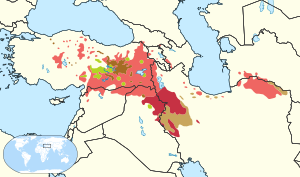Consonants

Kurmanji (Northern Kurdish)
Sorani (Central Kurdish)
Mixed dialect areas
| Labial | Dental/ Alveolar |
Palatal | Velar | Uvular | Pharyngeal | Glottal | ||||||
|---|---|---|---|---|---|---|---|---|---|---|---|---|
| plain | velar. | plain | labial. | plain | labial. | plain | labial. | |||||
| Nasal | m | n | ŋ | |||||||||
| Plosive | voiceless asp. | pʰ | tʰ | t͡ʃʰ | kʰ | |||||||
| vcls. unasp. | p | t | t͡ʃ | k | kʷ | q | qʷ | ʔ | ||||
| voiced | b | d | d͡ʒ | ɡ | ɡʷ | |||||||
| Fricative | voiceless | f | s | sˠ | ʃ | x | xʷ | ħ | h | |||
| voiced | v | z | zˠ | ʒ | ɣ | ɣʷ | ʕ | |||||
| Approximant | l | ɫ | j | ɥ | w | |||||||
| Tap/flap | ɾ | |||||||||||
| Trill | r | |||||||||||
- /n, t, d/ are laminal denti-alveolar [n̪, t̪, d̪], while /s, z/ are dentalized laminal alveolar [s̪, z̪],[6] pronounced with the blade of the tongue very close to the back of the upper front teeth, with the tip resting behind lower front teeth.
- Kurdish languages contrast plain alveolar /l/ and velarized postalveolar[7] /ɫ/ lateral approximants. Unlike in English, the sounds are separate phonemes rather than allophones.[8]
- Postvocalic /d/ is lenited to an approximant [ð̞]. This is a regional feature occurring in other Iranian languages as well and called by Windfuhr the "Zagros d".[9]
- Kurdish has two rhotic sounds; the alveolar flap (/ɾ/) and the alveolar trill (/r/). While the former is alveolar, the latter has an alveo-palatal articulation.[10]
Kurmanji
- Distinguishes between aspirated and unaspirated voiceless stops, which can be aspirated in all positions. Thus /p/ contrasts with /pʰ/, /t/ with /tʰ/, /k/ with /kʰ/, and the affricate /t͡ʃ/ with /t͡ʃʰ/.[2][8][11]
- Although [ɥ] is considered an allophone of /w/, some phonologists argue that it should be considered a phoneme.[12]
Sorani
- According to Hamid (2015), /x, xʷ, ɣ, ɣʷ/ are uvular [χ, χʷ, ʁ, ʁʷ].[13]
- Distinguishes between the plain /s/ and /z/ and the velarized /sˠ/ and /zˠ/.[14][15] These velarized counterparts are less emphatic[clarification needed] than the Semitic emphatic consonants.[15]
Xwarîn
- [ɲ] is an allophone of /n/, occurring in the about 11 to 19 words that have the consonant group ⟨nz⟩. The word "yanze" is pronounced as [jɑːɲzˠɛ].[16]
Labialization
- Kurdish languages have labialized counterparts to the velar plosives, the voiceless velar fricative and the uvular stop. Thus /k/ contrasts with /kʷ/, /ɡ/ with /ɡʷ/, /x/ with /xʷ/, and /q/ with /qʷ/.[17] These labialized counterparts do not have any distinct letters or digraph. Examples are the word "xulam" ('servant') which is pronounced as [xʷɪˈlɑːm], and qoç ('horn') is pronounced as [qʷɨnd͡ʒ].[18]
Palatalization
- After /ɫ/, /t/ is palatalized to [tʲ]. An example is the Sorani word "galte" ('joke'), which is pronounced as [gɑːɫˈtʲæ].[8]
- /k/ and /ɡ/ are palatalized before close vowels.[8]
- When preceding /n/, /s, z/ are palatalized to /ʒ/. In the same environment, /ʃ/ also becomes /ʒ/.[19]
Pharyngealization
- In some cases, /p, t, k, s, z/ are pharyngealized to [pˤ, tˤ, kˤ, sˤ, zˤ]. For example, the word "sed/ṣed" is pronounced as [ˈsˤɛd][8][4][20]
- Furthermore, while [fˤ] and [ɡˤ] are unique to Sorani,[5] Kurmanji has [t͡ʃˤ].[21]
Consonants in loanwords
- /ɣ/ is a phoneme that is almost exclusively present in words of Arabic origin. It is often replaced by /x/ in colloquial Kurdish. Thus the word "xerîb/ẍerîb" ('stranger', /ɣɛˈriːb/) may occur as either [xɛˈriːb] or [ɣɛˈriːb].[22]
- /ʕ/ mostly occurs in words of Arabic origin, mostly in word-initial position.[23]
- /ʔ/ is mainly present in Arabic loanwords and it affects the pronunciation of adjacent vowels. The use of the glottal stop in everyday Kurdish may be seen as an effort to highlight its Arabic source.[24]